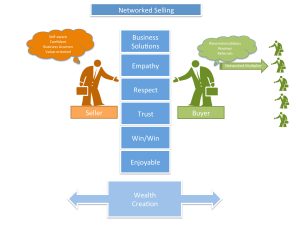For sales today, a mindset is at least as important as a skillset. In our ongoing series on this vital topic, we have already discussed the qualities of self-responsibility, individuality, security and freedom.
The next component required for a salesperson mindset is what we call Network Selling. Network Selling is a philosophy that we evolved and is expressed in the graphic below.

The basic reason it is called Network Selling is that today’s digital world is totally networked. You cannot make a move as a salesperson that doesn’t have some kind of impact, good or bad, throughout this network. You’re either recommended or warned about, right along with the product or service that you’re selling.
The Network Selling philosophy is designed to create a win-win situation, both for the buyer and the seller. When this has happened, the buyer will happily provide referrals to the seller, and as well, will recommend the seller’s product or service to others.
Let’s walk through each step of Network Selling, and see how it relates to and leads to the others.
Business Solutions
As you can see in the graphic, Network Selling starts with a business solution–you’re certainly not going to win either way (as a seller or for the buyer) without one.
The business solution arises out of the buyer’s need and pain points. You’re providing a solution that overcomes that need and eases pain points.
Empathy
It is vital that you, as a seller, fully understand your buyer’s need. That’s the only way the next step of Network Selling–empathy–will come about. Empathy is directly correlated to the needs and pain points of the buyer.
Empathy is more fully described in our ebook Emotions in Sales.
Salespeople sometimes misplace empathy and spread it all over the place. They might ask the buyer how it’s going, and the buyer might say, “Oh, you know, I’m going through a nasty divorce.” The seller at that point might express some empathy–but the seller has got to realize that all the empathy in the world for the buyer’s personal troubles will probably not lead to a sale. So empathy must be primarily used in the sales cycle.
Respect and Trust
How does respect come about between a seller and a buyer? It comes about through communication.
How is communication conducted in a sale? It can happen through online meetings, webinars, phone calls or on-site meetings. In all but one of those, it’s the seller’s voice that is going to create the biggest impression, because that’s all the buyer can perceive. The seller has to practice creating the right impression. The buyer has to be able to answer these questions immediately: “Is this seller an arrogant person? A caring person? A competent person? A nice person?”
Of course, this communication must be part and parcel of the earlier steps of Network Selling: a business solution must be offered that truly addresses the buyer’s need, and the communication from the seller to the buyer must convey genuine empathy.
A vital part of this communication–and one which salespeople too often leave out–is listening. The seller must hear, understand and rapidly respond to questions, and must be aware of the buyer being wary, or be aware of the buyer not understanding vital points about the product or service. If the salesperson doesn’t catch these subtleties, the sale will most likely be lost. Caught, though, they could very well win that sale.
Example: I always ask the buyer, “Is what I have shown you fulfilling your needs? Will it really help you?” When the buyer has confirmed that I have helped, I repeat back to the buyer what the buyer told me. “You said…”
It is through this communication that the buyer will ultimately respect the seller–or not. And through consistent respect comes the next stage of Network Selling: Trust.
Win-Win
As the opportunity moves forward through the sales process, it should be heading for a win-win, in which both the buyer and the seller come out ahead. All the Network Selling steps lead up to this one–but as with all the others, this one has its own characteristics within itself.
A vital component of a win-win situation is the price. Of course, the buyer needs a great price in order to win–but so does the seller. If the seller is forced to chop down the profit margin to the point where it’s practically non-existent, this is not a win for the seller.
It’s rather like some of the trade agreements that exist between the U.S. and other countries. If we take a look at the one between the U.S. and China, it is heavily balanced in favor of China, resulting in an enormous trade deficit of $347 billion in 2016 (U.S. exports to China were only $116 billion while imports from China were $463 billion).
The only way a business relationship will continue and thrive is if it results in a win-win for both sides, consistently.
Enjoyable
What do all of the above steps result in? An enjoyable buying experience–which is something any company, sales organization or sales rep is going to have to create to survive in today’s network world.
And as shown on the graphic, the successful establishment of all the Network Selling Steps results in wealth creation on both sides.
The New Currency
Network Selling also results in a type of currency for the new age of sales: referrals. It is this currency that, today, a salesperson lives by.
Pipeliner CRM totally supports every aspect of Network Selling. Find out more about Pipeliner CRM.





















Comments